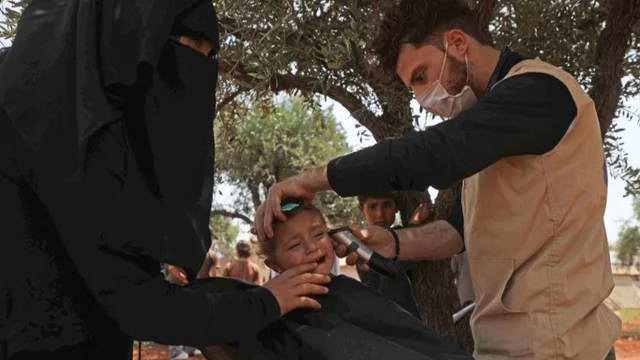Assad attempts to weaponize COVID-19 in Syria
COVID-19 has exacerbated Syria’s economic crisis to unprecedented levels. In recent weeks alone, the Syrian pound has lost more than half its value. President Bashar al-Assad argued that Syrians could not endure any more economic hardship. He reopened businesses and markets after a two-month lockdown in late April and lifted a daily curfew on May 26.
But it is not “business as usual.” In fact, as he has opened the country Assad has tried to ensure that those in opposition-held areas are more vulnerable to the pandemic. He is seeking to weaponize COVID-19 to help win his civil war.
The Syrian government has exploited the misery of civilians throughout the conflict. It has blocked humanitarian aid, besieged civilian areas, and bombed aid convoys. The regime has damaged or destroyed 84 medical facilities in the northwest since December, and an independent United Nations investigation confirmed that these were deliberate strikes. Civilian suffering is not just the consequence of Assad’s military operations; punishing civilians in rebel-held areas is the goal.
COVID-19 has provided Assad a new opportunity to instrumentalize suffering. He knows how vulnerable Syria is to the pandemic. Syria’s health care infrastructure has been fragmented, downgraded and destroyed throughout the country’s civil war, and it is woefully under-equipped to deal with the spread of COVID-19. Over the past nine years, 70 percent of all Syrian medical workers have fled the country. Against the odds, Syria has seemingly avoided a large-scale outbreak thus far. But now that Assad is lifting the lockdown, an uptick of infections is all but ensured.
Assad has worked to ensure that COVID-19 will hit opposition-held areas harder than loyalist areas. His government undermined the ability of rival authorities in the Syrian Democratic Council (SDC) to stem the spread of COVID-19 in the northeast. The government insisted that all samples for COVID-19 from the northeast be transported to Damascus to be tested in government labs. Tests confirmed that a 53-year-old man from the area had died from the virus on April 2. But the government prevented the World Health Organization (WHO) from telling the SDC that the pandemic had reached the northeast for 11 days. By then it was too late. Relatives of the man since have tested positive, demonstrating that community transmission has begun.
Assad also has obstructed UN agencies’ attempts to combat the pandemic in the northeast. The WHO repeatedly has requested the Syrian government’s permission to build its capacity in northeast Syria, where just 26 of 279 public health centers are functioning for a population of 4 million. The government in Damascus has delayed and obstructed these efforts. When it finally authorized a WHO shipment in mid-April, it ensured that supplies were funneled towards government loyalists. The WHO reported the delivery of a 30-ton medical shipment to northeast Syria on May 11, but SDC authorities did not receive any of this aid. The government also delayed the delivery of machines that test for the virus to local authorities and continues to prevent the WHO from establishing a COVID-19 testing laboratory in the area.
Russia has stepped in to defend its ally as evidence has grown that the regime is undermining efforts to combat COVID-19. On May 19, the Russian ambassador to the United Nations indicated that Russia would block any efforts to reauthorize UN humanitarian agencies’ use of an Iraqi crossing into northeast Syria. Using that crossing would allow the efficient delivery of medical equipment and supplies to opposition-held areas without the approval of the government. Russia forced the WHO to remove a plea to reinstate its use of the border crossing for medical deliveries in a draft paper presented to the Security Council.
Although no COVID-19 cases have been confirmed in the Idlib province in the northwest, Assad has made the region particularly vulnerable to the pandemic. Displaced civilians have flooded in from the rest of the country for years, and the Syrian army’s campaign into Idlib in December then displaced almost 1 million more civilians. Idlib is bursting with desperate people who lack adequate shelter, food, water and sanitation. Many live out in the open, under trees. Hand-washing and other basic preventative measures are impossible.
The uptick of the regime’s shelling of southern Idlib in recent weeks suggests that Syria and Russia are preparing for a new offensive. A former Russian deputy foreign minister recently argued that Russia has no option but to support a new Syrian attempt to retake all opposition-held territory in the area. A renewed offensive would provide the perfect conditions for the pandemic to spread more deeply in the area.
As I have argued elsewhere, UN Security Council members must place greater pressure on the Syrian government and its Russian allies to facilitate all UN operations to deal with COVID-19. They must stop Assad from using COVID-19 as another tool to stoke misery in Syria. The Middle East appears to have avoided widespread outbreaks of the pandemic, but Assad’s efforts to weaponize COVID-19 threaten a disaster.
The views expressed in this article do not necessarily reflect the views and editorial stance of the SOHR.
Source: Assad attempts to weaponize COVID-19 in Syria | TheHill

